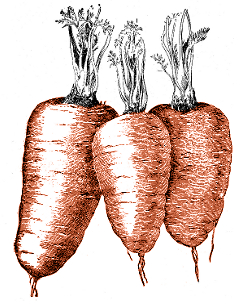Posts tagged ‘marigold’
Posted in Decorative, Experimentation, Garden Diary, Practicalities, The Old Garden In Bristol on Sunday, April 17th 2016 (9.18 PM).
This afternoon, I finished weeding the rosebay willowherb, until more shoots spring up at least. Weeded every shoot I could see, dug up every rhizome I could find, levelled out the soil and spread a layer of compost across the top.
The sowing plan for the bed starts with: peas at the back, against the trellis. Now, I’ve had issues with pea support in the past, and I suspected that the laths of the trellis are a bit big for a pea plant to wrap a tendril around, so the trellis has been covered in green plastic pea netting. It’s not the prettiest solution but it’s not too obtrusive; and I’m sure the vines of the back neighbour’s honeysuckle will love clinging onto it too.
In the front of the bed, we have scattered various seeds, mostly flowers, in the hope that the will grow up in front of the pea plants without eclipsing them entirely. We’ve scattered handfuls of:
- Cornflower, Centaurea cyanoides “Blue Diadem”
- Night scented stocks, Matthiola bicornis
- Corn marigold, Chrysanthemum segetum
- Poppy, Papaver rhoeas “Flanders”
- Swiss chard, Beta vulgaris vulgaris Cicla-Group “Five Colour Silverbeet”, because Gretchen has spotted it elsewhere and liked the different colours of the leaves.
- Tree spinach, Chenopodium giganticum “Magenta Spreen”, scattered from a packet I bought a couple of years ago and intended to sow but never did. The aim of the tree spinach is much as it was when I bought the packet: it has been sowed in the left-hand end of the bed, a dark and fairly damp corner where not much grows apart from dandelions. Tree spinach might prefer sun, but will hopefully cope with the shade there; and there won’t be any peas at that end that it might crowd out.
There are also nasturtiums, Tropaeolum majus “Empress of India”, apparently “a classic Victorian variety” according to the Internet, sowed in a couple of spots, their seeds like tiny miniature brains. The key to all of this, of course, is the idea that the peas are going to clamber up high enough and quick enough that none of the stuff around them will cause any problems. The other key, which you might have realised, is that nearly all of the ornamental (or semi-ornamental) stuff is self-seeding. Hopefully, once everything is set up, everything will keep on going year after year, or at least until we move house.
This is all very experimental and no doubt a Proper Gardener would tell us we were trying to cram far too many plants into a tiny space. However, we will wait and see. I won’t be surprised if not everything develops, or at least, doesn’t grow exactly how I originally envisaged things. It might need a bit of tweaking next year, or it might all come up again, irregular but satisfactory.
I’ve given up on the calendula seeds mentioned previously, and bought a new packet. Into pots, we sowed:
- More calendula, obviously.
- And more Tropaeolum majus.
- Mixed rocket leaves
- A different dwarf sunflower, Helianthus annuus “Choco Sun”, allegedly one of the smallest sunflower varieties available. Short enough for a toddler to sniff, I hope.
And with a general tidy-up, the garden is looking reasonable again. The back bed may be bare soil now, but hopefully within a month or two it will be full of greenery, and mostly the greenery we intended, too. In the tidy-up a lot of the wooden containers were thrown away, their wood rotted too far to save them, but that leaves us a good terracotta core. The plants we bought and potted up 2½ weeks ago are settling in nicely: the fennel looking lively, the thymes putting on new growth, and the marjoram already starting to fill up its pot. I’m rather pleased with how quickly things have been turned around. Even if things aren’t perfect yet, there’s not too much more tidying up left to do.
calendula, chard, corn marigold, cornflower, creeping thyme, fennel, french marjoram, green fennel, lemon thyme, marigold, marjoram, nasturtium, pea, poppy, rosebay willowherb, sowing, sowing plan, sunflower, swiss chard, thyme, tree spinach, weeding, Tropaeolum
Posted in Garden Diary, Photobloggery, The Old Garden In Bristol on Saturday, December 1st 2012 (8.36 PM).
This week, it really feels as if the garden is properly getting itself going. More and more insects are out and about, and more things are starting to come alive. The lettuce and calendulas sown three weeks ago have just made their first appearance above ground, and the pea seedlings which have been growing on the kitchen windowsill are getting larger and larger, stretching their tendrils like the most grotesque of scarecrows. Today I started hardening them off ready for planting out; I probably should have done it earlier.
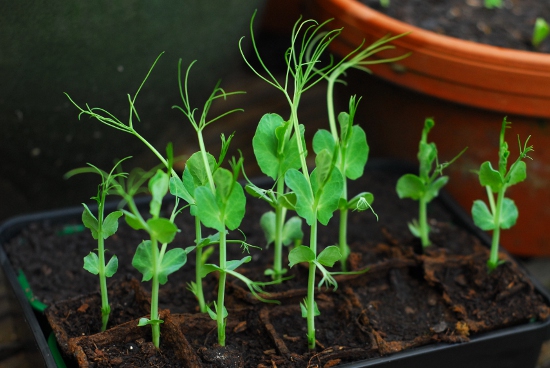
More peas will start germinating soon. The first batch of this year’s potato crop went into the ground today too – well, into their container. This year we picked Red Duke Of York, as something we are unlikely to see in the greengrocers, and I’ve tried to squeeze four tubers into the container rather than last year’s three. The second batch will be planted in about a month’s time.
To get the potatoes, we popped over to the Riverside in Southville. Naturally, we were rather tempted by their selection of herb plants. Possibly too tempted: intending go there purely to get potatoes, we also came home with a black peppermint, some sweet peas, and two fennel plants. The fennel is instead of the dill we grew last year; I will explain more about that later.
black peppermint, calendula, fennel, lettuce, marigold, mint, pea, peppermint, potato, spring, sweet pea
Posted in Experimentation, Garden Diary, The Old Garden In Bristol on Wednesday, February 29th 2012 (5.51 PM).
In the last post, I mentioned that although the rocket is in bloom already, there weren’t any hoverflies about yet. The very next day, I saw the first I’ve seen this year. Orange and black, it had gone before I had chance to grab the camera. It was warm in Sunday’s sunshine, and I could occasionally also hear bumblebees nearby – presumably queens looking for a nesting spot. The only one I saw was a good twenty feet away, not quite close enough to attempt an identification.
I was in the garden, because I’d decided that, with the weather being so warm, it was about time I started getting some seeds in the ground. Don’t want to leave it too late, after all: last year, because of when we started, we didn’t exactly grow the mixture of things we wanted. So Sunday was spent clearing compost out of all the pots which had had last year’s annuals in, and sowing a very few new seeds. In one pot: a mixture of calendulas and lettuce. A bit of an experimental mixture, and I’m not at all sure I have given them enough space to get along. Indoors, on the kitchen window sill: peas, germinating inside to avoid tempting the local wildlife. Peas are damn tasty, after all.
calendula, hoverfly, lettuce, little gem, marigold, pea, sowing, spring, wildlife
Posted in Retrospective, The Old Garden In Bristol on Saturday, October 1st 2011 (11.10 AM).
The list, in the previous post, of plants we’ve grown this year wasn’t really in any particular order; just off the top of my head as I cast my mind around the garden. Here, though, are some of the plants that we can say were a success.
Potatoes: probably our biggest success, grown in a dustbin with holes drilled in the bottom. We grew them in a mixture of soil and compost, at first, earthing up regularly with compost until it reached the top of the bin. I was expecting flowers and fruit, which we didn’t get; and we were rather worried about a leafhopper infestation which developed, damaging the leaves quite a bit. When the foliage died back, though, we upended the bin and found a healthy crop, about 600g per seed. Next year, we hope to have room for a couple more bins.
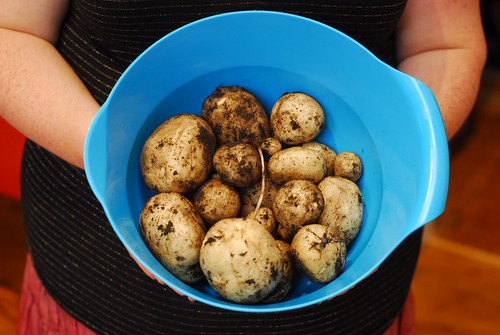
Peas: we bought small plants from the garden centre, planted them up in wine boxes, and put them on top of the garden wall, trained up the latticework. Again, each plant gave us a plentiful harvest; but we did have a bit of a mildew problem, probably caused by planting too many in each box.
French marigolds: we didn’t manage to eat any, but the plants themselves have gone happily on producing flowers all summer. They’re still in flower now, with more buds on the way.
Swiss chard: we planted this in a variety of containers, and tried harvesting and eating it at a variety of stages, from baby leaves to fully-grown leaves and stems. All of them worked pretty well: the baby leaves were ready fairly fast, and harvesting most of those left room for a few plants to grow into adulthood. Moreover, what we weren’t expecting was that we would be able to treat the adult plants in a cut-and-come-again fashion; we thought we’d harvested everything we could a few weeks back, but we now have healthy and harvestable leaves waiting for us again.
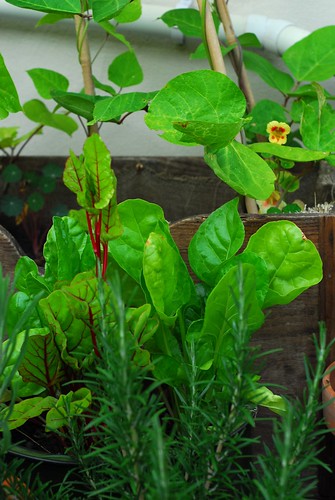
Mint: it grew, despite the best attempts of leaf-miners and caterpillars to eat it. Moreover, we kept forgetting we had mint leaves to use, leaving the mint bush to get rather overgrown and straggly; giving it a fierce trim rather more often would have left us with a healthier plant.
Feverfew: it grew very well, with attractive clusters of daisy-like flowers that have lasted well all summer. Now, we just have to work out what else it might be useful for.
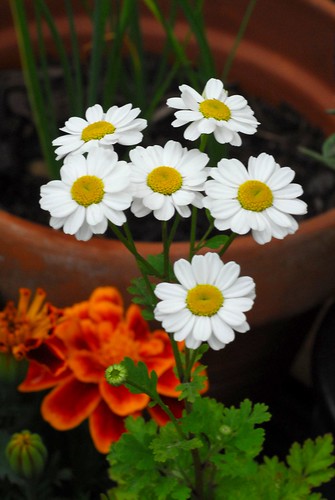
calendula, feverfew, french marigold, marigold, mint, pea, pentland early, potato, review, swiss chard

